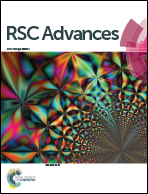Three dimensional M × N type aptamer-functionalized solid-phase micro extraction fibers array for selectively sorptive extraction of multiple antibiotic residues in milk†
Abstract
In this study, a novel three dimensional (3D) M × N type aptamer-functionalized solid-phase micro extraction (SPME) fibers array (M represents the number of targets; N represents the number of samples) was developed for selective enrichment of multiplex antibiotic residues from milk samples, with three chloramphenicols (CAPs) as models. First, gold nanoparticles (AuNPs) were electrodeposited on a gold wire (Φ = 0.2 mm), which was wound around a conductive indium tin oxide (ITO) glassy fiber. Then, the fiber was immersed into thiol-functionalized aptamer solution, which could specifically recognize three CAPs, including chloramphenicol (CAP), thiamphenicol (TAP) and florfenicol (FF). The aptamer can be covalently immobilized on AuNPs through Au–S bonds. Thus, a 3D aptamer-functionalized fiber interface (3D-Apt@AuNPs@Au wire–ITO) was built and employed for specifically sorptive extraction of CAPs from the milk samples with a matrix complex based on the high affinity of the aptamer for the targets. The extraction capacities for CAP, TAP and FF were 887, 840 and 801 ng per fiber, respectively. The enrichment folds were more than 500 times, which is 3.1 folds higher than that of the 2D-Apt@AuNPs–ITO fiber and 6.6 folds higher than that of the 1D-Apt@Au wire–ITO fiber. Afterwards, several similar fibers were assembled together into an array for simultaneous enrichment of three CAPs from 12 samples in one run. Finally, the adsorbed targets were washed away using a pH 8.5 0.1 M Tris–HCl buffer and then detected by high performance liquid chromatography (HPLC)-Diode Array Detector (DAD). The parameters, including extraction temperature, shuttle rates, extraction and desorption pH, and extraction and desorption time, were investigated and discussed. Under the optimized conditions, the limits of detection (LOD) and quantitation (LOQ) were determined as 0.262–0.293 and 0.864–0.967 ng mL−1, respectively, for several CAPs. The fibers array can be applied in replicate batch-extraction for at least 60 extraction cycles with a recovery of over 80%. The SPME fibers assay coupled with HPLC detection possessed advantages of high-throughput, high selectivity and adsorption capacity in one run. Furthermore, the process is environmentally friendly without using organic solutions during the entire extraction process. Thus, the method is a universal platform that can be extended to the selective extraction of other organic pollutant residues if the modified aptamers are changed.



 Please wait while we load your content...
Please wait while we load your content...